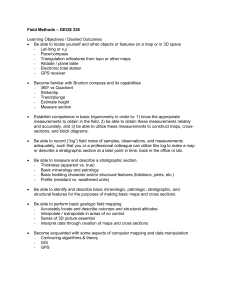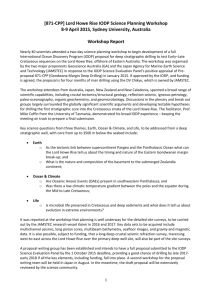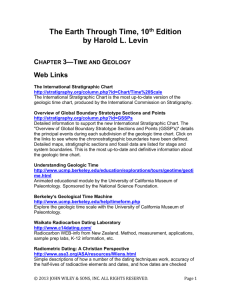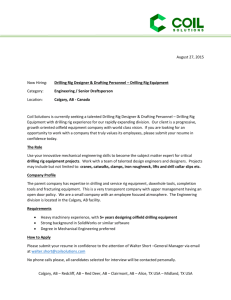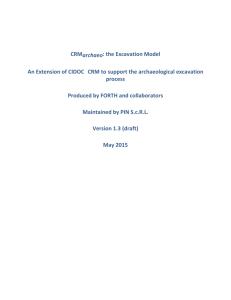4 th year (Spec. geology)
advertisement
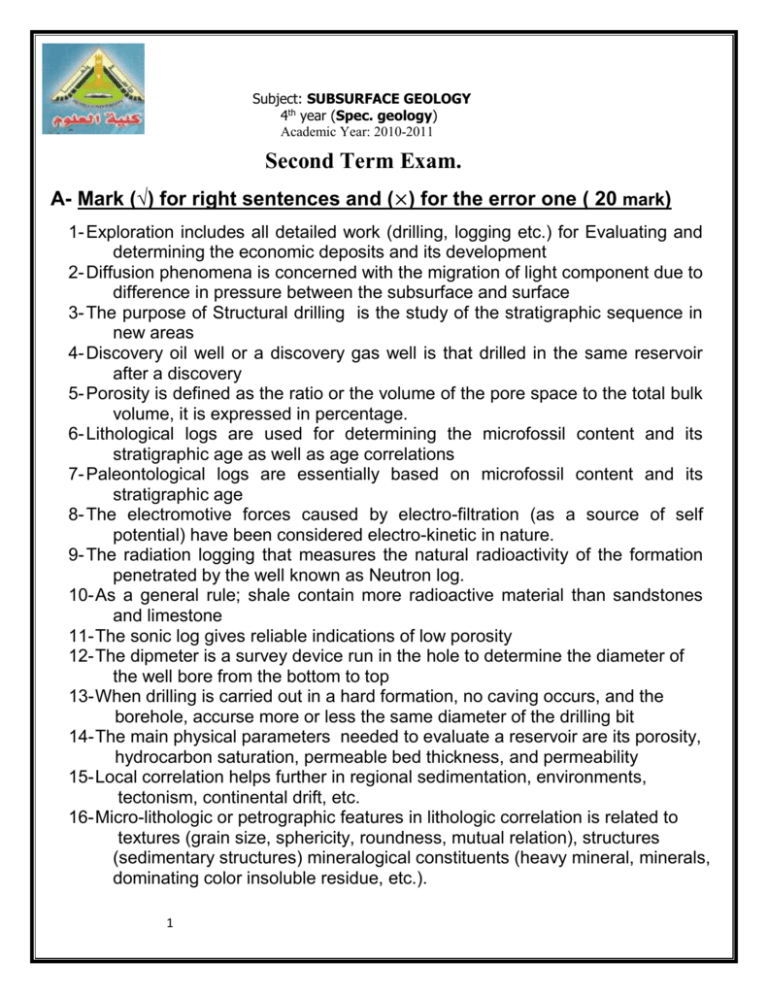
Subject: SUBSURFACE GEOLOGY 4th year (Spec. geology) Academic Year: 2010-2011 Second Term Exam. A- Mark (√) for right sentences and (×) for the error one ( 20 mark) 1- Exploration includes all detailed work (drilling, logging etc.) for Evaluating and determining the economic deposits and its development 2- Diffusion phenomena is concerned with the migration of light component due to difference in pressure between the subsurface and surface 3- The purpose of Structural drilling is the study of the stratigraphic sequence in new areas 4- Discovery oil well or a discovery gas well is that drilled in the same reservoir after a discovery 5- Porosity is defined as the ratio or the volume of the pore space to the total bulk volume, it is expressed in percentage. 6- Lithological logs are used for determining the microfossil content and its stratigraphic age as well as age correlations 7- Paleontological logs are essentially based on microfossil content and its stratigraphic age 8- The electromotive forces caused by electro-filtration (as a source of self potential) have been considered electro-kinetic in nature. 9- The radiation logging that measures the natural radioactivity of the formation penetrated by the well known as Neutron log. 10- As a general rule; shale contain more radioactive material than sandstones and limestone 11- The sonic log gives reliable indications of low porosity 12- The dipmeter is a survey device run in the hole to determine the diameter of the well bore from the bottom to top 13- When drilling is carried out in a hard formation, no caving occurs, and the borehole, accurse more or less the same diameter of the drilling bit 14- The main physical parameters needed to evaluate a reservoir are its porosity, hydrocarbon saturation, permeable bed thickness, and permeability 15- Local correlation helps further in regional sedimentation, environments, tectonism, continental drift, etc. 16- Micro-lithologic or petrographic features in lithologic correlation is related to textures (grain size, sphericity, roundness, mutual relation), structures (sedimentary structures) mineralogical constituents (heavy mineral, minerals, dominating color insoluble residue, etc.). 1 17- Biostratigraphic units are bodies of strata deposited during a specific interval of geologic time 18- Isochore map is regard to apparent thickness. 19- Tectofacies maps show the areal variation in tectonic aspect of a stratigraphic unit 20- Tectofacies maps enable the geologist to determine the shelf, basin, and geosynclinals tectotopes which may occur within the region studied as defined by the thicknesses and lithologic associations present in the section B- Select the best (correct) answer for 10 questions ( 20 mark) 1- The presence of oil and gas in the formations is usually detected in drilling mud by: a- “gas detector” instrument b- ultraviolet light viewing box (UVR reaction) c- ionization chamber d- a dip meter device 2- Drilling Time Logs give indication to a- The change in the lithology of the formations, b- Mineral Content, c- The kind of cement e- The degree of cementation 3- Electric logs is usually carried out a- Before casing the wells b- After casing the wells c- During casing the wells 4- Sources of self- potential are thought to be the result of a- Electro-filtration phenomena b- Diffusion phenomena c- Electro-osmosis phenomena d- Effusion phenomena 5- Electro-osmosis phenomena in measurement of the self potential log are a- A result of electrochemical action between the drilling mud of the well and the salt water of the formation b- Due to the difference of salt concentration between the drilling mud of the well and the salt water of the formation c- Directly proportion to the pressure and electrical resistivity of the liquid d- Inversely proportional to the velocity of mud filtration into the permeable bed. 2 6- The Physical evidences in litologic correlation are based on: a- Lithologic Identity b- Tracing lateral continuity c- Position in sequence d- Geochemical correlation e- Structural Relationships 7- Time-stratigraphic units correlation depends on a- The law of superposition of strata, b- Paleontologic control c- Structural relationships, d- The relative ages of the strata 8- The common difficulties in time-stratigraphic units correlation include a- Presence of unrecognized unconformities b- Limited amount of control c- Multiplicity of nomenclature d- Erroneously compiled data 9- The fundamental element for structural and stratigraphic mapping is a stratigraphic horizon, commonly termed as a- Key horizon b- Key bed c- Marker bed d- Structure horizon e- Palaeontologic horizon 10- A normal fault with a low-dipping plane appear as a zone known as a “datum gap”. The width of the gap depends on a- The degree of dip of the fault plane b- The amount of throw c- The marker bed d- The key horizon e- The angle between the strike of the marker bed and of the fault plane 11- Qualitative facies maps are a- Commonly made by plotting the dominant lithology of a stratigraphic unit at a number of control points by drawing boundary lines around them. b-Indicates the major Iithologic, biologic , or tectonic changes which took place during the deposition of a stratigraphic unit. 3 Subject: SUBSURFACE GEOLOGY 4th year (Special geology) Academic Year: 2010-2011 (Second Term Exam.) Model answer A B No √ × 1 2 3 4 5 6 7 8 9 10 11 12 13 14 15 16 17 18 19 20 ● ○ ○ ○ ● ○ ● ● ○ ● ○ ● ● ● ○ ● ● ● ● ● 4 ○ ● ● ● ○ ● ○ ○ ● ○ ● ○ ○ ○ ● ○ ○ ○ ○ ○ NO a b c d e 1 2 3 4 5 6 7 8 9 10 11 ● ● ● ● ● ● ● ● ● ● ● ● ● ○ ○ ● ● ● ● ● ● ● ○ ● ○ ● ○ ● ● ● ● ○ ○ ○ ● ○ ○ ○ ● ● ● ○ ○ ○ ○ ○ ○ ○ ○ ● ○ ○ ○ ● ○
